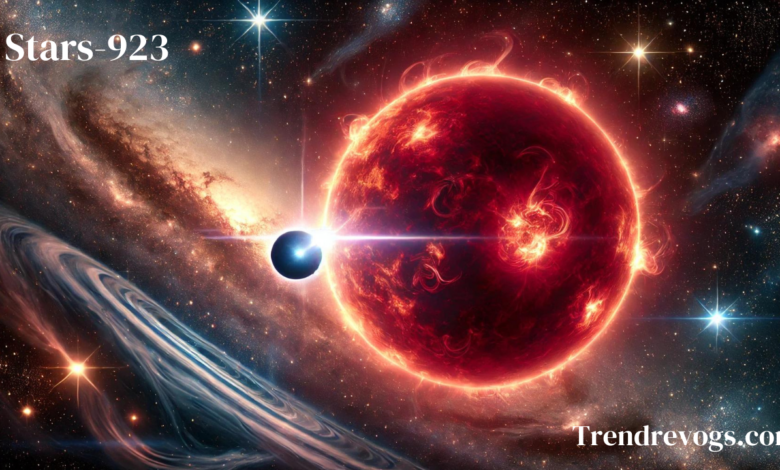Stars-923: A Cosmic Marvel of Binary Stars and Astrophysical Mysteries

The universe is filled with countless celestial wonders, each more intriguing than the last. Among these marvels, Stars-923 has captured the imagination of scientists, stargazers, and curious minds alike. Known for its unique characteristics, dynamic interaction, and potential to reshape our understanding of stellar evolution, Stars-923 is not just another star—it is a binary star system that serves as a window into the broader workings of the cosmos. So, what is Stars-923, and why does it hold such importance in the field of astronomy?
The Stars-923 Binary System: A Tale of Two Stars
At the heart of Stars-923 lies a fascinating binary system consisting of two distinct celestial objects—a red supergiant and a neutron star. Binary star systems, where two stars orbit a common center of mass, are more common in the universe than our single-star solar system. However, what sets Stars-923 apart is the nature and interaction of these two stars.
The primary star in this system is a red supergiant, a massive star nearing the end of its life cycle. Red supergiants are some of the largest and most luminous stars in the universe, often expanding to sizes that dwarf our Sun. In the case of Stars-923, the red supergiant is estimated to be 1,500 times the radius of the Sun, radiating immense energy as it undergoes nuclear fusion of heavier elements. The eventual fate of this star is to explode as a supernova, releasing vast amounts of energy and potentially leaving behind a neutron star or black hole.
The secondary star in the Stars-923 system is a neutron star, a dense remnant of a previously exploded massive star. This neutron star is also a pulsar, meaning it emits beams of electromagnetic radiation from its poles as it spins rapidly—completing a rotation in just 1.5 milliseconds. The interaction between the red supergiant and the pulsar creates a highly dynamic system that provides a unique laboratory for studying stellar evolution.
Mass Transfer and Accretion: A Cosmic Tug of War
One of the most remarkable aspects of the Stars-923 system is the process of mass transfer between the red supergiant and the neutron star. As the red supergiant expands, its outer layers are pulled toward the neutron star due to gravitational forces. This material forms an accretion disk around the neutron star, which gradually spirals inward, releasing enormous amounts of energy in the form of X-rays. This process not only affects the neutron star’s mass but also influences the red supergiant’s evolution, as it loses material and gradually decreases in size.
The accretion process in Stars-923 is not just a passive transfer of material. The intense gravitational interaction can significantly alter the fate of both stars. If the neutron star gains enough mass through this process, it could reach a critical point where it collapses into a black hole, an event that would mark the ultimate transformation of the binary system. This possibility adds a layer of excitement and mystery to the study of Stars-923.
Stars-923 and Supernova Explosions
The final fate of Stars-923 is tied to one of the most spectacular events in astronomy—a supernova explosion. When the red supergiant exhausts its nuclear fuel, its core will collapse, triggering a supernova. For stars as massive as Stars-923, this explosion is a cosmic event of tremendous significance. The energy released during a supernova is enough to outshine entire galaxies for a brief period.
Supernovae are also responsible for dispersing heavy elements like carbon, oxygen, and iron into the surrounding space. These elements are essential for the formation of planets and, ultimately, life. The supernova event in Stars-923 will play a critical role in enriching the interstellar medium with these elements, contributing to the ongoing cycle of star formation and galactic evolution.
The Role of Stars-923 in Astrophysical Research
The study of Stars-923 has far-reaching implications for our understanding of the universe. One key area of research is stellar evolution—the process by which stars form, live, and die. By observing Stars-923, astronomers can refine their models of how stars evolve and what factors influence their eventual fate. The red supergiant’s transformation into a supernova, followed by the potential collapse of the neutron star into a black hole, provides a real-time example of these processes in action.
In addition to stellar evolution, Stars-923 is also important for studying neutron stars and gravitational waves. Neutron stars are some of the densest objects in the universe, and their extreme conditions provide a unique opportunity to study physics that cannot be replicated on Earth. The rapid rotation and strong magnetic field of the neutron star in Stars-923 allow scientists to observe phenomena such as pulsar timing and magnetar activity, which can deepen our understanding of these exotic objects.
Observing Stars-923: A Glimpse into the Universe
For amateur astronomers and stargazers, observing Stars-923 is a thrilling experience. While the star system is too distant to be seen with the naked eye, it can be observed using high-powered telescopes. Professional observatories, both on Earth and in space, have captured detailed images of Stars-923, revealing its structure and behavior.
Spectroscopy, a technique that analyzes the light emitted by celestial objects, has been particularly useful in studying Stars-923. By examining the star’s spectrum, scientists can determine its composition, temperature, and movement through space. This data is essential for determining the star’s role in the galaxy.
Star3 and Its Cultural Significance
Beyond its scientific importance, Stars-923 has also inspired a sense of wonder and fascination among people throughout history. Stars like Stars-923 have played a vital role in mythology, navigation, and art. In ancient times, sailors relied on stars for navigation, using their positions in the night sky to guide their journeys across oceans. Meanwhile, artists and writers have long been inspired by the beauty and mystery of the stars, creating works that capture the vastness of the universe.
In modern times, Stars-923 continues to spark curiosity and awe. Its dynamic nature and the potential for a supernova explosion make it a star system worth watching. As technology advances, we can expect even more discoveries about Stars-923 and its place in the cosmic tapestry.
Conclusion: The Future of Stars-923
The story of Stars-923 is far from over. As astronomers continue to study this binary system, discoveries are sure to emerge. Whether it’s through the detection of gravitational waves, the observation of its supernova explosion, or the potential formation of a black hole, Stars-923 will undoubtedly continue to play a significant role in advancing our understanding of the universe. For now, it stands as a reminder of the incredible complexity and beauty of the cosmos, offering endless possibilities for exploration and discovery.




